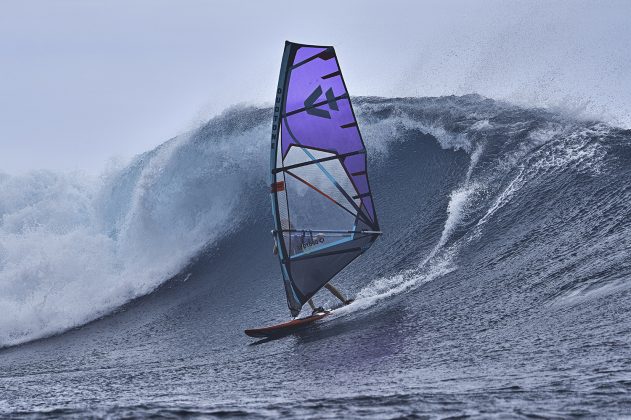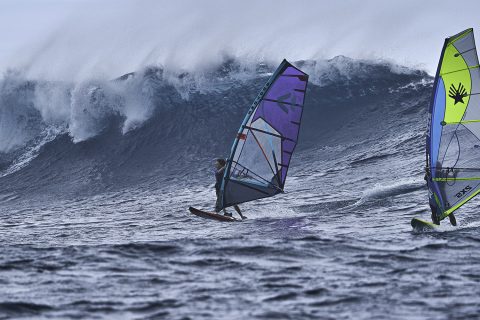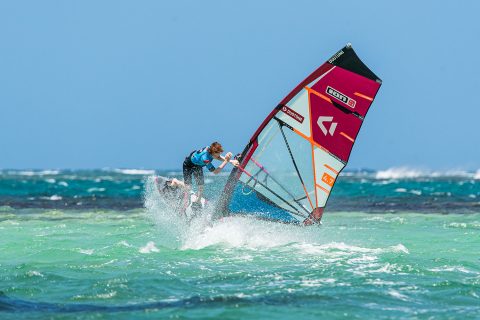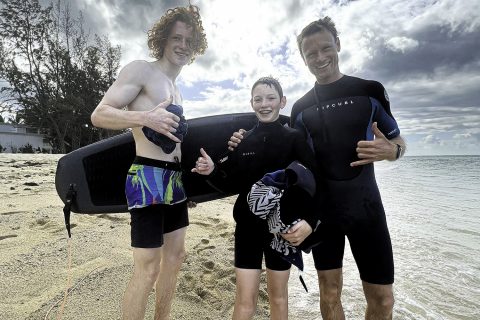FIRST REEF: LE MORNE
Fifteen-year-old K66 Team freestyler, Freddie Sargent, trades the Witterings for Le Morne, Mauritius and shares his experience of riding his first ever reef waves there!
WORDS – Freddie Sargent// PHOTOS – Eye Sea You Photo, Louis-Arnaud Lavasier, Guy Cribb, Stewart Grant.
When I started windsurfing (aged about ten), my Dad would encourage me by saying ‘you’re going magazine speed!’ I loved the idea of going as fast as the people in the pictures. Five years later and we’re on a family holiday in Mauritius in search of a ‘magazine wave’. I’ve sailed in waves on the south coast of England many times. West Wittering is perfect for jumping and onshore wave riding, but the waves don’t look the same as in the magazines – they’re breaking all over the place with short gaps between them. There are no rules other than don’t crash into people and try to remember where you launched from. It turns out that the waves you see in magazines are a bit more complicated. There are obviously rules about priority on the wave, but knowledge about how to stay out of trouble is also required. Here’s what I learnt.
Spikey!
At home the waves break onto a sandy beach, which is kind on the feet but the smooth gradient from the waterline gives an almost featureless sea floor and, with no guidance from below, the waves do their own thing, breaking all over the place. By contrast, instead of soft sand, a reef break is sharp, hard and spikey! Best not to think about what’s under there! Reefs create an underwater map for the waves to follow, which help line up waves into more predictable sets in ideal conditions. A deep water channel next to the reef in which waves rarely break helps too, so that you don’t have to sail out through breaking waves.
Le Morne, Mauritius
Le Morne, on the southwestern tip of Mauritius, has a number of reefs offshore, with channels running through them and waves peeling on either side. In the morning, before the wind picks up, the waves are great for surfing, but the trade wind, when it arrives, is in the perfect direction (cross-offshore) for wave sailing.
On one side of the reef system is the famous ‘One-Eye’ break – a fast and hollow wave; we avoided that one! A more user-friendly first-time wave experience is ‘Manawa’ which, despite looking quite gnarly, is significantly safer, as the waves break into a channel and so, if things go wrong (and you get stuck on the inside), the current will eventually take you into the deep water channel where you can escape or be rescued.
When it goes well
Despite being a relatively safe wave, my Dad (an ‘expert’ because he’s done it once before) felt compelled to give me a few survival tips before we headed out to Manawa for the first time.
When it goes well, the wave starts breaking and peels from right to left in more or less the same place every time. The bigger ones break a bit further out to sea and a bit closer to the channel, but you can see the bubbles in the water from the previous waves as a guide to where the next waves will break.
When everything goes to plan, you sail in towards the beach upwind of the break and pick up a swell 100 metres or so before it jacks up into a wave. You then bear away so that you can keep up with the swell (which, before it breaks is going very fast) and you line yourself up so that you’re heading just inside (on the channel side) of where you think the wave is going to break. As you wait for the wave to wall up, stay high on the wave until it’s almost breaking and then just have fun! So long as you’re going along the wave (downwind) as fast or faster than the wave is peeling you’re safe and in heaven – the water is smooth and you feel like you’re going 1000 miles per hour (magazine speed). When the wave starts to get smaller (and the water gets shallow) you can gybe off the wave into the channel and start your upwind slog back to the ‘start line’!
When it goes bad
When you’re in the right place, with the power of the unbroken wave behind you, you feel safe and in control and ready to try bottom turns and top turns. Just a few metres behind you is the ‘wrong place’ where things get broken. Dad’s first bit of advice was to make sure you’re always in the right place! Despite his great knowledge on this topic, he managed to break his own fairly basic rule on day one – he tried to sail through the breaking zone during a lull in the sets thinking he could get to the ‘starting point’ in one tack instead of two. A big set came that he had no chance of sailing through (and there wasn’t enough wind to ‘chicken gybe’ and outrun the wave) and so his day ended early with a broken mast and a journey back in the rescue boat.
His second gem was to warn us about the ‘section’. Manawa is an almost perfect wave, but it doesn’t always peel at a constant speed. Sometimes, especially when the waves are big, a section of the wave breaks ahead of the peeling part. You can usually see that this is about to happen and, if you’ve got enough speed, you can bear away along the wave to get past the section. However, if someone has dropped in on you and is blocking your way (so you can’t race the section), or if you’re just not paying attention, you can get caught by it.
If the wave breaks on you, then you’re in for a period of being washed by successive waves, then probably a long swim, followed by a few minutes of trying to waterstart on the inside over the shallow (waist deep) reef where the broken waves have less power, but the wind is at its lightest.
Manawa, being friendly, eventually washes everything back into the deep water channel, but it can take a while and you’re generally fairly knackered by the time you’re back in the game.
Dad’s final tips were about minimizing the chances of breaking kit or getting hurt:
- If the wave catches you on the way out (and if you have time), bury the mast tip in the water facing the wave and hold onto the boom and mast (just above the boom) for as long as you can for a shorter swim, unless the wave is massive!
- Never hold the clew end of the boom; the sail will flip in the wave and could break your wrist.
- Stay calm and don’t kick your feet too much (move slowly) when in the shallow water on the inside to avoid kicking the reef.
- Always tell someone where you are, sail with a buddy and at breaks that are a long way offshore, like Manawa, only sail when there is a rescue boat.
First wave feeling
The long sail out to Manawa is intimidating; you can’t help questioning the wisdom of being such a long way from shore with a cross-offshore wind in a channel whose current takes you out to sea. Strangely though you feel safer when you arrive and join the pack of sailors – there are people around who will hopefully notice if you’re in trouble. When your turn comes and you pick up a swell with nobody else on it, the adrenaline starts to kick in. Dropping in on a half-pipe requires a single moment of commitment. By contrast, when you’re sailing in on a big swell, you become gradually more committed as the wave jacks up until the point of no return, and this seems to intensify the sense of excitement. The choppy water becomes smooth, the swell slows down a bit and the power of the wave takes over from the power of the sail. Then you’re on it – you’re looking down from the top of the wave at the perfectly flat water 12 foot below, and you’re ready to go. It’s a view that few people in the world will see.
Clinics
Sailing in bigger waves for the first time is a little scary and having a pro to teach and look out for you reduces the anxiety. Guy Cribb, Simon Bornhoft, Jem Hall and Peter Hart all run clinics in Mauritius as well as other great wave sailing spots. Going on a clinic is a fantastic way to learn, with video feedback and a coach who knows which small tips can make all the difference. We were on holiday with Guy Cribb who organized a private rescue boat for the whole of his coaching course. At sunrise he teaches foiling from it and even towed us into the longest rides of our lives on his hydrofoils, and by day it’s our private rescue boat, giving us confidence to ride Manawa – which is otherwise a very scary place to be. He videos us with his low flying drone from the boat and also brings photographers on it – a massive bonus to the trip! I feel so lucky to have had the opportunity to go to such an amazing place and have these experiences. I caught my first reef wave at Le Morne, but it definitely won’t be my last!




